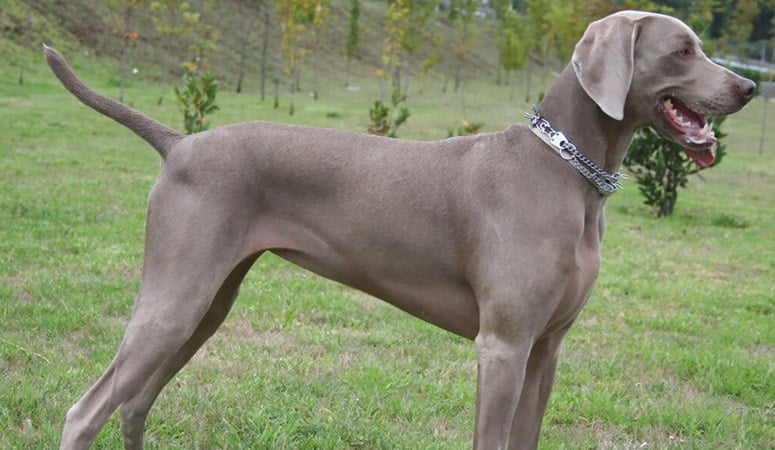Weimaraner

Friendly, obedient, and beautiful, the Weimaraner, or “Gray Ghost”, is beloved by the hunters and pet owners. This breed is built to move with great speed and endurance and combines grace, stamina, and an alert demeanor, which is a highly sought-after dog in their native Germany and one of the popular breeds in America now.
| Other Names | Weimaraner Vorstehhund |
| Color | Blue, Gray, Silver Gray |
| Height | Males: 23-28 inches. Females: 22-26 inches. |
| Weight | Males: 66-88 pounds. Females: 55-77 pounds. |
| Life Span | 10-13 years |
| Personality | Friendly, Fearless, Obedient |
| Exercise | Needs Lots of Activity |
| Origin |
| Popularity | #39 |
| Groom Needs | Weekly |
| Kids Friendly | Yes |
| Dog Friendly | Yes with supervision |
| Watch Dog | |
| Family Dog | |
| Litter Size | 6-8 |
Weimaraner Pictures
Weimaraner Video
Introduction
Weimaraner is a large hunting-type dog, noted because of its distinctive greyish-silver coat. It comes with strength and loyalty, making a great family pet. It has other names too; known as a Weimaraner Vorstehhund, Gray Ghost, or Weim. They are pretty smart these dogs, sometimes referred to as the “dog with the human brain”. When they are born, they have pale blue eyes but later, they fade to a beautiful blue-gray or amber color. Also when they are just puppies, their skin is like stripy, but these fade away within a few days. Their sense of smell is very intense, that’s why they have been used as tracking dogs to find missing people. Their paws are also webbed which makes them excellent swimmers. The dogs have a muscular, athletic appearance, emphasized by their short hair and shiny coat. They stand about 28 inches high, weighing in at about 88 pounds. You get long-haired dogs too, but they are less common. Weimaraners need proper training so that their energy and impulses are managed properly – they love to be around people all the time, so separation anxiety is common in these dogs – in fact, they stick to their owners to the point where it can become a behavioral problem. If you are away from home a lot, the Weimaraner won’t be the dog for you.
Living with Weimaraner
This short, smooth-coated breed sheds year-round but does not require excessive grooming or care. Weekly brushing with a bristle brush can keep his coat and skin healthy and remove the loose hair off clothes and furniture, and bath only when needed.
Droopy ears like the Weimaraner’s tend to have issues with ear infections, you need to check the dog’s ears weekly and wipe them out with a cotton ball moistened with a cleanser. Also, skin irritation can happen to Weimaraners, the main reasons are food allergies or sensitivity to grooming products.
Brush your Weimaraner’s teeth at least two or three times a week to remove tartar buildup and the bacteria that lurk inside it, the daily brushing is better to keep fresh breath and prevent gum disease.
Besides, the owners need to keep their nails short, regular trimming is recommended to prevent painful splitting, cracking, or breaking.
Weimaraners who exercise high energy need a lot of physical activity to be happy and well-behaved, the more activity, the happier this energetic breed will be. They need to take one to two hours of high-intensity exercise every day to prevent undesirable behavior, which can be in the form of a long walk, or preferably, long jog. Hunting is their favorite exercise, and swimming and retrieving are also favorites.
A lot of speed will bring high exercise endurance, so make sure to leave enough space for your Weimaraner to roam. This is not a breed for inactive owners, they are very suitable for country life.
The Weimaraners like eating, a piece of meat is more attractive for them, but they can also go for whole foods like vegetables. Owners need to feed a highly rated food that has a moderately high protein content. Generally, it is recommended to feed a Weimaraner with high-quality dry dog food for two to three cups per day, more importantly, based on average weight and activity level. This amount should be divided into two or three meals and should be fed after extensive activity to prevent bloat.
If feeding kibble, pet owners can add water to dry food. But if canned food or table scraps are enhanced dry food, you should be careful to not add too much because too rich food can upset their digestion.
As a very active breed, the Weimaraners get more than just accidental cuts, scrapes, sprains and pulls. They like to chew, which can cause damage to the mouth and gums. Be careful of them ingesting things that should not go down a dog’s throat.
The Weimaraners may be prone to the following conditions: bloat, hypertrophic osteodystrophy (HOD), elbow and hip dysplasia, peritoneopericardial diaphragmatic hernia, generalized demodicosis, meningitis, spinal dysraphism, von Willebrand disease, tricuspid dysplasia, pododermatitis, neutrophil function defect of Weimaraners
Major concerns: bloat (gastric dilatation and volvulus)
Minor concerns: CHD, entropion, vWD, spinal dysraphism, distichiasis, hypertrophic osteodystrophy, hemophilia A,
Occasionally seen: PRA, dwarfism, eversion of nictitating membrane, ununited anconeal process, tricuspid valve dysplasia, hypothyroidism, persistent right aortic arch
Suggested tests:
Hip Evaluation
Thyroid Evaluation
Ophthalmologist Evaluation
Total Annual Cost: $3239
Cost is estimated for the first year and may vary depending on many factors, such as dog food, health care, leash, collar, licensing, possible fencing, crates, training and obedience classes, dog-walking, grooming, treats, toys, flea, tick, and heart-worm meds, microchips, etc.
Weimaraners are very smart, they can learn quickly, but that includes both good and bad behaviors. They may be stubborn, if consistent, ongoing training begins in early puppyhood, they can learn basic obedience easily. Without a dedicated training plan and resources, Weimaraners are not ideal for their owners.
Advanced training is a good way to burn off some of the Weimaraner’s excess energy. Their talents and impressive problem-solving skills make them ideal for advanced training such as agility, dock diving, nose training, tracking, and as a therapy dog.
Originally bred as a hunting companion, the Weimaraner is a solid choice as a hunting dog breed that is because his keen nose makes him a scent dog with his nature to hunt. Early and continuous training is necessary to channel the energy and wisdom of Weimaraners in a beneficial way.
History
These beauties originate from the city of Weimar, Germany. Its roots are believed to stem from the 18th century. It was thought that Karl August, who was the Grand Duke of Saxe-Weimar-Eisenach, and who ruled Weimar from 1758-1815 bred the dogs. However, there are similar-looking dogs that can be traced as far back as the 13th century, in France.
The Weimaraner Club was formed in 1897, allowing only 1500 dogs to be registered at a time.
In 1920, this breed was brought to the USA by a man named Howard Knight, but still, the breed wasn’t recognized by the American Kennel Club (AKC) until 1942.
After World War II, a lot of American servicemen brought Weimaraners back home with them and they quickly grew in popularity after that.
US President Dwight Eisenhower and his family had a pet Weimaraner named Heidi, in 1955. The dog, however, urinated on an expensive White House rug and was sent to live on the Eisenhowers’ farm in Gettysburg, Pennsylvania.
Princess Grace Kelly was a Weimaraner fancier – she received one as a wedding gift when she married Prince Rainier III of Monaco in 1956.
Helpful Information
Breed Club: WEIMARANER CLUB OF AMERICA
Breed Club Link: http://weimaranerclubofamerica.org/
Breed Club Rescue:
Breed Club Rescue Link: https://weimaranerclubofamerica.org/rescue.php




